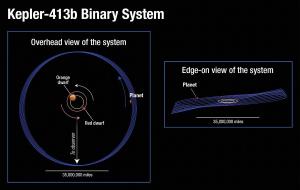Blog
Wibbly Wobbly
6 February 2014
 NASA and ESA
NASA and ESAA few days ago I wrote about a planet that orbits two stars. Now a new circumbinary planet has been discovered, named Kepler 413b. This planet is particularly interesting because its orbit is tilted about three degrees from the orbital plane of the two stars, and this results in some interesting planetary dynamics.
The discovery of this planet is an example of why long term observational data is useful. The Kepler space telescope discovers exoplanets through what is known as the transit method. When a star’s planet passes between us and the star, some of the starlight is blocked by the planet, making it slightly dimmer. The change isn’t much, only a small fraction of a percent, but it is enough to measure. Kepler does this by observing the brightness of a star over a long time period.
The catch is that the exoplanet must pass in front of the star for us to detect it. This means its orbit must be along our line of site. In the case of Kepler 413b, it basically is along our line of site, but because its orbit is titled relative to the stars, the orbit shifts a bit over time. This means sometimes the orbit is along our line of sight, and sometimes it is a bit off.
As a result the transits of the planets didn’t follow a regular pattern. The Kepler data for this particular star covered about 1500 days. Within that period there were three transits spaced 66 days apart, then 800 days of no transits, followed by five more transits. Because of the motions of the stars and planet, the next transit isn’t expected until 2020.
So it was really just lucky chance that this planet happened to be in alignment while Kepler was observing.